February 28th Regular Meeting Recap
Click here to view the agenda and packet information for this meeting
Click here to view the meeting recording
Restricting Virtual School Enrollment – Commonwealth Virtual Schools (CMVS) are virtual schools that serve the whole state and are approved by the Board of Elementary and Secondary Education.
Under Massachusetts State Law a school committee may “restrict enrollment of its students in commonwealth virtual schools if the total enrollment of its students in commonwealth virtual schools exceeds 1 per cent of the total enrollment in its district; provided, however, that no student enrolled in a commonwealth virtual school shall be compelled to withdraw as a result of that vote.”
The Department of Elementary and Secondary Education (DESE) has determined based on student enrollment data reported to them on October 1st, 2023 that more than 1% of students from Pittsfield are enrolled in a CMVS. Under DESE Guidelines the School Committee must vote by March 1st if it is considering restricting student enrollment in the CMVS.
Based on this information, the School Committee voted to restrict enrollment in CMVS to 1% in a 6 – 1 vote (I opposed the motion).
Terminology: Fiscal Years (FY)
FY23: July 1st, 2022 – June 30th, 2023
FY24: July 1st, 2023 – June 30th, 2024 (our current fiscal year)
FY25: July 1st, 2024 – June 30th, 2025 (our next fiscal year)
February 28th Budget Workshop Recap
Click here to view the agenda and presentation for the meeting
Click here to view an audio recording I made of the whole group presentations at the beginning
I should note that both iBerkshires and the Berkshire Eagle were present at the meeting, including for the group rotations.
Building an Understanding of the Budgeting Process
We were given an overview of the budget process and a review of the budget calendar. Here is where we currently stand with our calendar:

Overview of State Aid, Enrollment Projections and Grants
State Budget Process
- Governor released House 2 on January 24, 2024
- House Ways and Means budget released mid-April
- House final usually late April
- Senate Ways and Means budget released May
- Senate final usually mid to late May
- Conference Committee meets to resolve differences between House and Senate bills
- Final budget to the Governor for signature and line item veto process (late June)
- House and Senate votes to override vetoes (July and August)
Governor’s Budget Proposal
The Governor’s proposed budget for FY25 (House 2) increases Chapter 70 aid (state aid for public schools) by 4% ($263 million). In FY24 the Governor’s budget proposal increased it by 9.8% ($568M).
How is State Aid Calculated (Roughly)
There are 2 components that dictate how a district’s Chapter 70 aid is calculated.
Foundation Budget: This is the amount the state figures it will cost for a school district to adequately and equitable run the district. This is all figured out through a complicated formula, which was recently changed with the Student Opportunity Act to make education funding more equitable throughout the state, which is currently being phased in.
Local Contribution: This is the amount the state figures that the municipality (in this case the City of Pittsfield) should pay towards the foundation budget amount based on the municipal property tax and the relative wealth of the community.
The amount districts receive in state aid is the difference between the foundation budget and calculated local contribution.
This whole process is much more complicated than that and I am still wrapping my head around it, but that is the brief 1,000ft overview of how it all works!
Areas Impacting the State Aid Increase of the Pittsfield Public Schools
Inflation rate: The inflation rate for everything other than for employee benefits is set at 1.35% for FY25. In FY24 it was set at 4.5% (which is actually the inflation rate cap set by law, if there was no cap we would have been over that percentage).
Enrollment: Pittsfield’s foundation enrollment has decreased by 19 students (0.34%). The English Learners foundation enrollment has increased by 63 students, however.
Low-income student count: The low income student count for Pittsfield has decreased by 90 students. This has resulted in Pittsfield moving from the 11th tier for low income students to the 10th tier. The cut off for the 11th tier is 70% low income students, and we are sitting at 69.96%, which is about 2 students away. If we remained in the 11th tier we would receive between $1M – $2M more in state aid this year. It was mentioned that there seems to be a mismatch between the district’s list of low income students and the Department of Elementary and Secondary Education’s (DESE) list, and the district has reached out to DESE to figure out what is going on.
Local contribution: The local contribution percentage based on the Governor’s proposed FY25 budget for Pittsfield is 37.8% of the foundation budget. In FY24 the rate was 34% of the foundation budget (a difference of $1.7M).
Based on all of this our state aid increase for FY25 based on the Governor’s budget is $649,248. This is a substantially less increase than we have seen in prior years.
COVID-19 and ESSER Grant Funding
As a result of the COVID-19 pandemic, the district has received various grants to respond directly to the pandemic and its indirect impacts on students. One of those grants, Elementary and Secondary School Emergency Relief (ESSER) III, is required to be used by September 30th, 2024.
Positions Currently Under ESSER III Funding (Total of 44 Full Time Equivalent Positions)
- Literacy Coaches @ 5 Elementary Schools
- SEL Interventionist Teacher Pilot @ Conte
- Emergency and Safety Coordinator @ District
- Dean of Students @ PHS
- Teacher of Deportment (3) @ THS
- Additional Content Teachers (5) @ THS
- Family Engagement and Attendance Coordinators @ MCS, CCS, CES
- School Adjustment Counselors 8.0 FTE
- Social Emotional Learning Coordinator
- Teachers of Deportment (2) @ Reid
- Paraprofessionals (2) @ Allendale
- Assistant Principal of Teaching and Learning at Egremont
- Teachers (2) & Paraprofessional @ Stearns
- Computer Technician @ District
- Special Education Instruction and Accountability Coordinator @ District
- Early Childhood Coordinator @ District
- Dean of Students @ Allendale
- Dean of Students @ Herberg
- Main Office Secretary @ District
- Additional Math Teacher for Multilingual Learner Support @ PHS
- Academic Interventionist @ Allendale
FY25 Enrollment Projections
Please check out the linked presentation for all of the enrollment projections that the district has calculated.
But here is the summary of the information that was presented to the School Committee:
- Student enrollment is a major budget driver,
- Disparities in class sizes across the district (some class sizes fall below the class size guidelines),
- In order to reduce expenses to the district, this enrollment data gives the administration a sense if we can close an elementary school if there is a need to make that decision. School closures require a vote of the School Committee.
Small Group Discussions with the District Leadership Team
After the 2 presentations the School Committee and District Leadership split up into 3 groups to view a presentation and discuss 3 different key areas of interest for our upcoming budget based on the district’s core values.
All budgetary information at this point are for informational purposes only and do not represent a final budget proposal by the district. The final proposals will be presented at our March 13th School Committee meeting.
Supporting Tier 1 Instruction
In this group we discussed the purpose of the Assistant Principal’s of Teaching and Learning in supporting and evaluating educators, and the purpose of the curriculum coaches in supporting educators.
We also discussed the various restorative justice practices that are used in the district, including the use of RISE and Reset Rooms.


And we also discussed class sizes and that there is no concrete data that says smaller class sizes makes a difference, but the major factor that influences the outcomes of students is the quality and skill level of the teacher.
Based on this discussion, this is the presented financial impact on Supporting Tier 1 Instruction and adjusting class sizes to current guidelines:

Supporting Academic Excellence
In this group we discussed the various College and Career readiness programs and initiatives going on locally and across the state. We primarily focused on Taconic’s expansion of its Career and Technical Education programs, including an addition of a new Environmental Science program starting this fall. We also focused on Pittsfield High’s new Innovative Pathways program.
We also discussed supporting multilingual learners. Currently there are 470 Multilingual learners (MLL) in the district, and the district is asking for additional MLL teachers to support these students.
And we also discussed Early Childhood Education. Currently there is a Early Childhood coordinator position which ends this year with a salary of $87k. The coordinator focuses not only on Pre-K but also on the early elementary school grades (K-2). The Department of Teaching and Learning is asking to maintain this position and to reduce one of their current positions in their department.
Based on this discussion, this is the presented financial impact on Supporting Academic Excellence:

Supporting Student Engagement & A Sense of Belonging
In this group we discussed the purpose of School Adjustment Counselors (SAC) in supporting student’s Social and Emotional Learning (SEL) and mental health, as well as the purpose of school psychologists for conducting student evaluations. We discussed how based on survey and evaluation data that there is a lot of SEL need for our students. There is a recommended ratio of 1 School Adjustment Counselor for 250 students, and currently 8 SAC positions are currently funded by ESSER III.
We also discussed chronic absenteeism, which the state is currently focusing on. A student is considered chronically absent if they have 18 or more absences in a given school year. Here is the chronic absentee rate for each school last year:

Currently per the teacher union’s contract, there is a requirement to have 10 half days through the school year for professional development. There is lower student attendance on those half days for various reasons, which increases the chronic absentee rate for the district and makes instruction less effective on half days. To eliminate 8 half days it would require the district to add 4 full days to the teacher’s work year, which would come at a cost of around $1M, and add 8 half days to the paraprofessionals work year, which is around $160,000.
Based on this discussion, this is the presented financial impact on Supporting Student Engagement and A Sense of Belonging:

Next School Committee Meetings
Our next regular meeting that is scheduled is Wednesday, March 13th at 6pm at City Hall in City Council Chambers. This will be the meeting where the district’s proposed budget for FY25 will be presented.